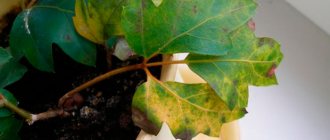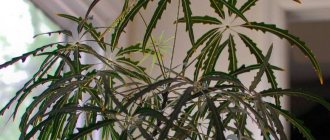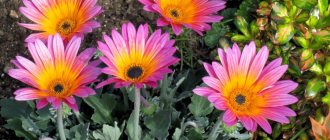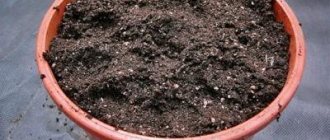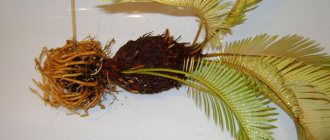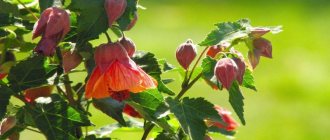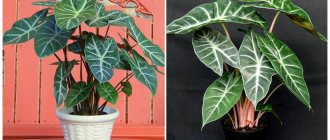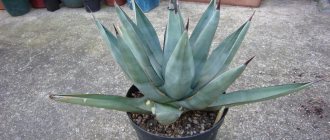Chamaedorea is known among indoor plant lovers as the bamboo palm.
It got its name from its leaves and thin trunks, similar to bamboo. Another name for the palm is mountain palm, received because in nature this plant can only be found in the mountainous areas of South and Central America.
Botany describes about a hundred species of palm trees; they grow in tropical and subtropical climates, with high humidity and temperature.
The plant prefers shady places, mainly at the foot of tall trees.
The choice is yours
There are several types of plants that differ significantly in external characteristics.
Chamaedorea elegans is usually grown at home. The second name of this pinnate palm with long lanceolate leaves is Neanta.
In the photo, chamedorea graceful
This species grows slowly, producing 2-3 pairs of leaves per year, begins to bloom early, and when mature the plant reaches a height of 2 meters.
Chamaedorea elatior is also popular - another type of mountain palm, but in appearance it is very different from Chamaedorea graceful with wide leaves coming from a thin trunk.
The trunk has ring-shaped marks from fallen leaves. The flowers of this palm are orange, collected in a panicle inflorescence.
Hamedorea Ernest-Augustus and metallic are similar to each other with wide, forked leaves that are pointed at the ends.
Both have a thin single trunk, but the leaves of the metallic palm stand out with the special color and shine that gives the palm its name.
How to properly care for indoor flowers?
Hamedorea is a perennial plant belonging to the Palm family.
It has approximately 130-140 varieties. This exotic plant is native to the tropical regions of East Africa, Central America and Madagascar. Some subspecies of Hamedorea can be found even on the Crimean Peninsula, the Caucasus and the southern regions of Europe. Most often, shrubby forms of palm trees are found, but there are also single-stem representatives and even lianas. The plant is considered slow-growing , since it can form only 1-2 young leaves per year.
The plant is divided into male and female specimens. They differ in the shape and color of the inflorescences. In male plants, the flowers are collected in inflorescences and can have a red or bright yellow tint, while in female plants the flowers are single, and are colored in a rich orange or red hue.
Hamedorea is considered to be a rather unpretentious plant; in most apartments and private houses it feels normal both in summer and winter.
It is best to leave the palm tree in shade or partial shade, follow the recommended watering sequence and regulate the humidity level in the room. So, you won't have problems with her.
Temperature and lighting
All those who decide to purchase such a palm tree need to immediately remember that high temperatures will kill it quite quickly.
So you cannot allow a constant temperature in the room with a flower to be +27 degrees or higher for a long time. The optimal temperature indicators for chamedorea are +22…+24 degrees. And in the cold season, +16...+18 degrees will be enough.
In general, you need to be careful with adjusting the temperature when caring for palm trees. It is known that at +12 degrees, chamedorea will begin to wither and die because it will freeze.
The best place to grow the plant is a room with a minimum of sunlight or diffuse sunlight. Since it has already been said that these flowers do not tolerate heat, you need to keep in mind that an abundance of sunlight will lead to yellowing and falling of the leaf blades of the palm tree (and its death, accordingly).
The most unpretentious are Hamedorea graceful and Hamedorea unicolor. They can be installed on a shaded windowsill. Other varieties are more demanding, so it is better to install them away from windows and the sun.
Although there is a flip side to the coin: some types of Hamedorea may not have enough sunlight in winter in the middle zone. And the plant needs a sufficient amount of light, because it is flowering.
The palm tree should spend about 12 hours in the light. So if there is a lack of lighting, you should think about purchasing artificial lighting.
Watering and spraying
Many gardeners believe that watering is the most labor-intensive process in caring for chamedorea.
After all, it is important here not only to maintain the balance of the incoming liquid, but also to accurately calculate the time when this liquid needs to be added. Unfortunately, there is no single irrigation scheme for this palm tree. Too many external factors can influence it. As a standard, most stick to 2-3 waterings per week in the summer. In winter, you need to add a new portion of water no more than once a week. But still, it is best to personally calculate the regime, based on observations of the plant. It is worth adding water when the soil in the pot is at least half dry.
Water for palm trees must be left to settle for several hours before adding to the substrate. You can use boiled water (just let it cool completely). Although many recommend watering with warmer water (the temperature should be slightly above room temperature), it’s still not worth the risk.
The palm tree should also be sprayed periodically:
- In summer, the spraying procedure should be carried out daily.
- In winter, spraying should be minimized or completely eliminated until the weather warms up.
- As a preventative measure, many gardeners recommend bathing the palm tree in the shower. Once every two months you need to place the container with the plant in the bathtub and water its leaves, trunk, as well as the top layer of soil with a shower with a slight pressure of cool water (not ice and not cold!). This procedure helps get rid of some types of pests and sufficiently moisturize the palm tree.
Hygiene
To keep the leaf blades of chamedorea clean, you need to spray it regularly (in summer), and also give it a cool shower according to the scheme described in the previous paragraph.
In what pots and soil does it grow quickly?
There is no consensus on what kind of pot the chamedorea needs.
So you will have to experiment a little with pots of different diameters and see which containers your palm tree likes best. You can prepare the substrate yourself: take leaf soil, peat and sand in equal parts and mix them. Monitor the acidity of the resulting mixture; it should remain within 5-6.5 pH.
You can also plant the plant in purchased soil. To do this, purchase the Palma mixture and add a little sand to it.
Fertilizer and feeding
In the wild, chamedorea does well without a large amount of organic fertilizers, since it grows mainly in poor soils. However, indoor varieties of this plant need support and fertilizer, since their planting capacities are limited:
- During the warm season, fertilize twice a month as the plant actively grows and forms foliage.
- In winter, you can feed the palm tree once every 1-2 months. But it is better to pay attention to the appearance of the plant during this period. If it looks normal, then you can completely eliminate fertilizers until spring.
- It is best to use purchased mixtures designed specifically for ornamental plant species.
- However, ideally, you should give preference to specialized compounds that are used only for palm trees.
Overfed chamedorea can become an easy target for various pests and infectious diseases. So it is better to reduce the dose of fertilizing recommended on the package by about half.
Palm tree pruning
Hamedorea does not require any special pruning, since it is independently capable of forming the correct crown shape.
However, drying or wilted leaves will need to be removed yourself. Remove dried ends of leaf blades using a sharp, disinfected tool. To keep plant stress to a minimum, sprinkle the cut edges of the leaves with cinnamon powder or charcoal.
Even if you do not trim the wilted elements, the chamedorea itself will shed dead leaves and renew itself. But still, you shouldn’t leave such elements.
Plant dormancy
During the plant's dormant period, several important rules must be followed:
- exclude fertilizing (can only be applied if the plant is not feeling well);
- reduce watering;
- lower the temperature in the room with the palm tree (but do not drop it below +15 degrees);
- spray rarely or not at all.
Buying a plant
Hamedorea can be found in flower shops - often it is a small bush with many basal shoots. It is difficult to find a large palm tree because it grows slowly and is therefore very expensive.
When choosing a plant, you need to pay attention to the leaves - they should not be dull, dried out or brown at the ends. A new plant brought home should be left to rest for several days so that it gets used to the new environment.
After 7-10 days it will be possible to start dividing the bush and replanting.
Planting process
To plant chamedorea, you need to select developed sprouts with their own root system, fresh leaves and strong stems.
Soil is poured into a small pot. You can use the soil you prepared yourself or buy a composition in the store that will include all the necessary ingredients.
Hamedorea palm seedlings
For palm trees, the best solution is a mixture of equal parts of turf, peat and humus, with the addition of half of clean river sand.
Leaf and coniferous soil are also suitable for growing palm trees. The mixture should be light, water- and breathable - for this effect you can supplement the earthen composition with vermiculite, coal or coconut shell shavings.
Features of care
The Hamedorea palm tree is valued not only for its appearance, but also for its unpretentiousness in terms of maintenance and care.
Despite its tropical origin, the palm tree feels good at temperatures from 12 degrees, the optimal option is 16-20 degrees.
The palm tree does not like direct sunlight, so it is necessary to place the flower pots in partial shade or shade, near western, eastern and northern windows.
You cannot place the plant on a cold floor - cold promotes the development of root diseases. To avoid this, you can place the pot on a stool or a special stand.
The plant should be watered as the top layer of soil dries out and the higher the air temperature, the more water is needed; it is advisable to spray the leaves or rinse them with warm water in the shower.
The water needs to be settled and warmed to room temperature. There is no need to fertilize young bushes transplanted into fresh soil.
Adult plants are fertilized with compounds for palm trees or universal complexes.
Care according to the calendar
Depending on the time of year, there are some care features:
- In summer, the palm tree is taken out onto the balcony, slightly shaded. Watering is provided abundantly, using fertilizers once every two weeks. The crown needs to be sprayed and the leaves wiped clean from dust. Once a week you should turn the pot 180 degrees so that the crown grows evenly.
- In the fall , the plant is brought indoors and the plant is watered less frequently. In the northern regions, where daylight hours are sharply reduced, you can install a phytolamp for the palm tree.
- In winter , the plant should be protected from drafts, watering should be reduced to once every 10-14 days, and fertilizing should be reduced to once a month.
- In the spring, young palm trees are replanted or reloaded with new soil and a larger pot, watering is increased more often and the plant fertilization regime is changed.
Hamedorea flowers are not decorative and are usually removed immediately, but if you want to save them and get seeds, then during the flowering period you can change fertilizers using special ones intended for flowering plants.
You need to be more careful about watering, and do not allow water to get on the flowers during spraying.
Video on how to care for chamedorea at home:
Description of Hamedorea
The Hamedorea palm was brought from Mexico, central and southern American regions, where it grows in mountainous areas. In the wild it is a small, graceful-looking palm tree. It grows in height to about 2 m. The trunk is thin, the diameter does not exceed 3 cm.
Many types of plants are grown indoors, including palm trees. It is chamedorea that is very popular and widespread among them. They decorate rooms, spacious offices, and winter gardens.
Kinds
There are several dozen varieties and varieties of chamedorea. But only 3 of them are well suited for home growing. You can see what they look like in the photo of chamedorea.
- Ernest-Augustus. This plant is a bush. It grows up to 100-110 cm. It has a compacted trunk that resembles a reed. Develops up to 10 two-lobed leaves. During the flowering period, red flowers are formed. The plant has aerial roots, which distinguishes it from its counterparts.
- Graceful. Another name for it is Hamedorea elegans. Grows up to 150 cm. Can be single-trunked or multi-trunked. The trunk is thin, the leaves are dark, feathery, 6 pieces on the trunks. The flowers are orange with a reddish tint.
- Single color. A hardy variety, unpretentious in care. Very similar to the elegans species. The trunk consists of internodes of leaf blades that have dried out. The flowers of this plant are yellow.
By following the recommended rules for growing palm trees, you can grow a wonderful plant indoors that will decorate your home for many years.
Plant propagation is not easy, but it is possible
Hamedorea can be propagated by dividing the bush, by root shoots or by seeds.
The bush can be divided when transplanting, carefully separating part of the palm roots, which will be transferred to a new pot. Propagating a palm tree using root shoots is even easier and safer for the plant, since palm trees do not like their root system being disturbed.
Sprouts 4-6 cm high are separated from the bush and planted separately, provided that the sprouts have their own developed roots.
With bright diffused lighting, constant high humidity and warmth, plants take root in 1-2 months. Sprouts that have taken root and become stronger are transplanted after 4 months to a permanent place.
Care must be taken to ensure that the roots do not remain exposed - this can lead to the death of the plant.
Reproduction of Hamedorea by dividing the bush
Use of seed material
Hamedorea also reproduces by seeds and planting material is easy to obtain at home if you do not remove the inflorescences, but treat them, transferring pollen with a soft brush from male flowers to female ones.
Ripe or store-bought seeds are sown in March or April ; you should not delay planting, since the seeds lose their viability quickly and, if they are more than a year old, they are unlikely to germinate at all.
The seeds are soaked for 5 days, the thick shell is scratched, placed in moist soil and the temperature is maintained at 25-27 degrees. Seeds germinate in 35-45 days.
To maintain the level of humidity and temperature, cover the box with seedlings with transparent polyethylene or glass, remembering to ventilate the plantings once a day. With the appearance of the first leaf, the sprouts are transferred to separate pots.
Step-by-step instructions for growing
Hamedorea can be grown from seeds. This method of propagating an exotic plant requires careful preparation of planting material and proper care.
Stages of growing Hamedorea:
- Pre-soaking of planting material. For Hamedorea, clean water is used. The seeds are left for 5-6 days.
- Use a grindstone to damage the top layer of planting material. This method will ensure greater penetration of moisture.
- Place the prepared grains in the seedling container (the sawn-off parts should be located at the bottom).
- Place the containers in a greenhouse to create a greenhouse effect.
- For 6-8 months, carry out regular ventilation and moistening of the soil.
Homemade seeds sprout after 1.5-2 months. You will have to wait six months for seedlings from purchased planting material. For transplantation, use sprouts whose leaves have reached a size of 4 cm.
Time and features of transplantation
Flower growers usually transplant Hamedorea in late spring. Plants purchased in stores also require replanting - in this
In this case, it can be done at any time of the year.
Young palm trees are replanted once a year, and adult large plants once every two to three years, when the roots begin to occupy all the free space in the pots and come out through the drainage holes.
For each transplant, the pot should be wider than the previous one by 2-3 cm in diameter and higher. It is necessary to lay drainage made of expanded clay, small broken bricks or ceramic fragments at the bottom.
This will help remove excess water, preventing acidification of the soil and the development of infections that affect plant roots.
When replanting annually, you do not need to remove all the soil from the roots of the plant and trim them - the palm trees are simply transferred to a new pot.
The roots of plants bought in stores can be cleaned, but only a little.
The rhizomes of diseased plants require high-quality treatment; you need to wash them in water, remove shoots affected by rot, treat them with special means and sprinkle them with coal.
After this, the roots are carefully straightened and sprinkled with earth, lightly pressing it around the trunk.
Care problems
Despite the fact that the chamedorea palm tree does not have any special care requirements, problems still occur when growing the plant at home - one of the most common is drying out and yellowing of the tips of the leaves.
This indicates a lack of moisture - the palm tree needs to be watered more and its leaves need to be sprayed.
In species of Chamedorea tall, Ernest - Augusta and others with a single trunk, drying of the lower leaves is the norm, especially if new ones grow at the same time.
Drying of young leaves, their grayness and withering mean problems with the root system, its rotting. You can save the plant by transplanting it into a new pot, smaller in size with a looser substrate.
Sometimes brown spots may appear on the leaves - this is the result of sudden changes in temperature, draft or improper care of the leaves.
To solve the problem, it is enough to move the chamedorea to a warm place, and wipe the leaves with a damp soft cloth, without any additional means, and spray regularly.
The plant is on the verge of death
Diseases and pests
If the rules of care for chamedorrhea are violated, a number of problems can arise. Dry tips of leaves indicate too dry air. Yellowing of the leaves appears when placed in direct sunlight or watered with hard water. When the roots rot, the plant begins to droop, wither and die. In this case, it is necessary to cut off the rotten roots and replant them in new soil, not forgetting drainage; it is also important to regulate watering. Darkening and brown spots on the foliage are formed from excess moisture or from too low temperatures, and this can also occur due to watering with hard water. At low temperatures, the foliage turns black and droops. With aging, the lower leaves themselves begin to wither and fall off. There is nothing wrong with this and when they lose their decorative appearance, they can be trimmed.
If kept in too dry air, spider mites may appear, which make themselves known by yellow spots on the foliage and thin cobwebs. To get rid of the pest, the plant can be washed with soapy water or sprayed with onion peel infusion. If there are a lot of pests, then it is better to resort to an insecticide. Scale insects can be identified by brown growths on the foliage.
It is difficult to remove them, but simply spraying them with preparations will help little, so you need to soak a cloth in insecticide and peel off the shields by hand. Mealybugs leave behind a white, cotton-like coating. The pest can be collected manually, but this will only help at the initial stage, and in the future you will have to resort to chemicals. Among the insecticides we can highlight Actellik, which copes well with all of the above pests. It is only worth noting that in case of massive damage, repeated treatment may be required after a week.
